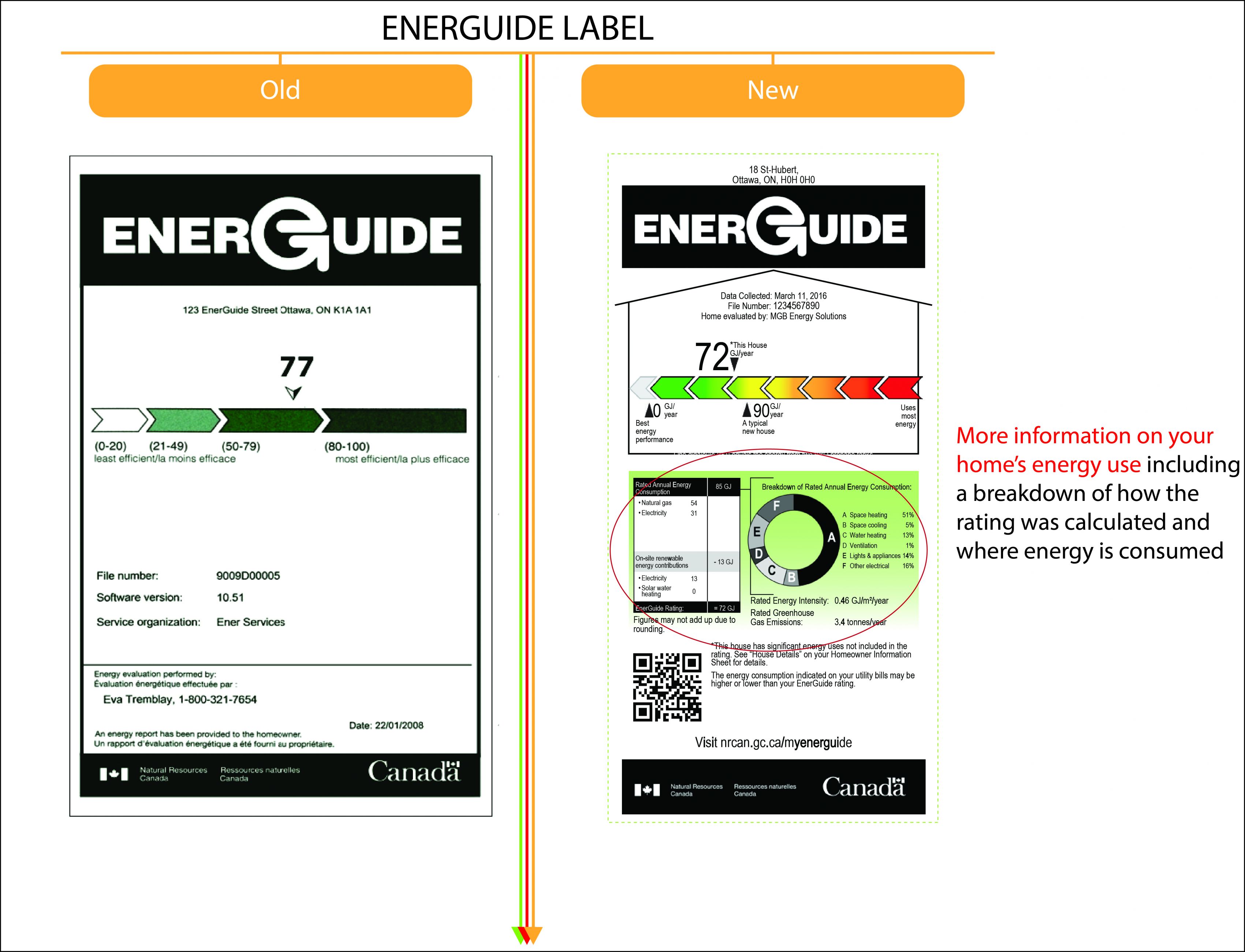EnerGuide Rating System version 15
Why is the EnerGuide Rating System being updated?
Natural Resources Canada is in the process of updating the EnerGuide Rating System for homes in order to provide homeowners with increased access to customized information about the energy performance of their homes. This information can help with decision making when purchasing, operating or renovating a home.
The updates are being made to ensure our home energy performance rating tool reflects energy efficiency construction and renovation practices. More than 300 key industry stakeholders were consulted as part of the update process, which was then open to a nationwide public review period.
During the consultation process, stakeholders from across Canada made it clear that the EnerGuide Rating System is being called upon to meet more needs and be more robust than ever before. For example, the rating system is now being used to support:
- Development and implementation of regulations;
- Design and implementation of utility, government and industry programs;
- Design and evaluation of high performance and net zero energy homes.
What were some of the key updates to the EnerGuide Rating System?
Some of the main updates include:
- Introduction of a new, consumption-based rating scale using gigajoules per year (GJ/year);
- Redesigned informative house label;
- New rating details report for homeowners;
- New renovation recommendations report for homeowners;
- Changes to elements included in the rating;
- For the professionals who deliver the rating system: updated energy modelling software, house evaluation procedures and quality assurance procedures; and
- Updated delivery network testing, licensing and registration.
What are the differences between the old and new EnerGuide labels?

Text Version
Shown are two EnerGuide labels, the old on the left and the new on the right.
Old Label
The old label displays an EnerGuide Rating with a 0-100 scale that indicates least efficient to most efficient. It also includes the address, the date of the energy report, the file number, the name of the energy advisor and the service organization.
New Label
The new label displays a home’s energy through a “rating” (a rating of the homes’s energy consumption will be provided in gigajoules). Homeowners should:
- Aim towards “zero” (the lower the number on the new EnerGuide scale, the better the energy performance of a home);
- Understand “energy” usage (the label breaks down energy consumed by source);
- Compare a home’s “performance” (the label shows how a homes’ performance compares to a benchmark home);
- Find out where the most energy “consumed” (the label shows proportion of energy consumed by heating, cooling, ventilation, etc);
- View the impact on the “environment” (the label shows a home’s Greenhouse Gas Emissions).
In our ongoing efforts to build on the strengths of the EnerGuide label, Natural Resources Canada updated the EnerGuide Rating System and the EnerGuide home label to provide more information to homeowners. The EnerGuide rating demonstrates the energy performance of a home, rather than an indicator of energy efficiency.
The updated EnerGuide label has brought many improvements including:
- New EnerGuide rating scale gives you a consumption-based rating measured in gigajoules per year (GJ/year). The annual gigajoules per year rating allows you to see your score using units of energy similar to how you would see a consumption rating of kilowatt hours per year for home appliances, miles per gallon for vehicles, or calories per serving for food.
- Your home’s EnerGuide rating calculation helps you understand your energy sources and the math that produced your home’s rating. The more intuitive rating scale makes it easier to understand the lower the number, the better energy performance of the home.
- Unique and innovative label design is an energy performance snapshot of the more detailed information that you will find in the new Homeowner Information Sheet and allows you to see at a glance the largest energy uses in your home.
- Your reference house, uniquely created for every home that’s rated, allows you to compare your rating to the rating your house would achieve if it were built to meet typical new home energy performance construction requirements.
For how long will the old EnerGuide label still be issued?
Most jurisdictions and EnerGuide partners have now transitioned to the GJ rating scale. As a result of this success, and in order to ensure a consistent, national home energy rating system, NRCan will retire the 0-100 rating system December 31st 2018. As of January 1st 2019*, all new EnerGuide Rating System evaluations must take place under the GJ system.
*A few limited exceptions may apply for those partner programs with a pre-established end date.
If I have an existing EnerGuide label, can I update it to the new label?
Ratings based on the 0-100 scale cannot be converted to the new gigajoules per year rating. This is because the updated EnerGuide rating includes types of energy uses and some new calculations that were not previously included. However, the recommendations you received under your existing label are still valid.
To obtain an updated EnerGuide rating and label, along with Homeowner Information Sheet, homeowners need to have a new EnerGuide home evaluation performed on their home, using the updated version of the rating system.
I just purchased a home that had an EnerGuide evaluation, can I get a copy of the EnerGuide rating and report?
The homeowner who purchased the EnerGuide rating services is the owner of the EnerGuide reports for the home and NRCan is bound by privacy laws to only share reports with the party that purchased them. However, homeowners are encouraged to share the reports with prospective homebuyers as part of the property selling transaction.
Page details
- Date modified: